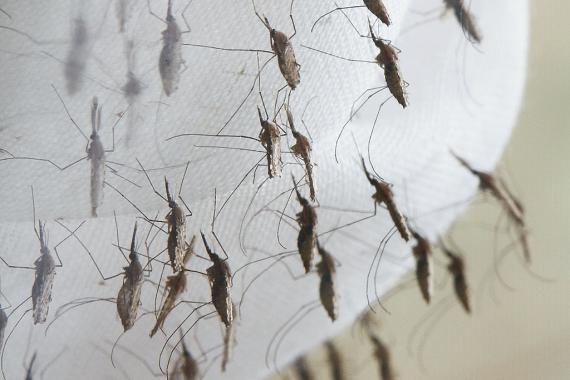The use of a genetically modified mosquito designed to reduce wild populations quickly is being expanded in a city in Brazil, which is experiencing one of the worst outbreaks of mosquito-borne diseases. With more than 1.5 million cases of dengue in 2015 and an estimated 1.5 million cases of Zika, a virus similar to chikunguynya that has been linked to birth defects since October 2015, Brazil is facing a major public health crisis.
The British firm Oxitec created the genetically modified Aedes aegypti mosquitoes, the major carriers of viruses that cause Zika, as well as dengue and chikungunya. The company designed their mosquitoes so that when they release modified males into the wild, they mate with females to produce offspring that do not survive into adulthood. After several successful trials, Brazil’s national biosafety group (CTNBio) approved the mosquito for release throughout the country.
In May 2015, the Brazilian city of Piracicaba started the world’s first municipal project of genetically engineered mosquito control with Oxitec’s mosquito. After positive early results the city has now decided to expand the project and support a new production facility, the company announced yesterday. Oxitec is also applying for trials in the Florida keys but has yet to be granted approval and has faced intense opposition from anti-GMO activists and some in the local population. “We cannot stress strongly enough how dangerously misguided this application is. Oxitec hopes to use the neighborhoods and precious ecosystem of the Keys as their private, for-profit laboratory,” said Wenonah Hunter, the executive director of Food and Water Watch in response to Oxitec’s original proposition to run trials in Key West, which was eventually defeated.
 Are genetically modified insects dangerously misguided? Will these releases of engineered mosquitoes work? What obstacles will it face? The answer lies within a close inspection of how this technology works and what experts think about the growing use of biotechnology in combating insects that endanger human health.
Are genetically modified insects dangerously misguided? Will these releases of engineered mosquitoes work? What obstacles will it face? The answer lies within a close inspection of how this technology works and what experts think about the growing use of biotechnology in combating insects that endanger human health.
To create their mosquito, Oxitec used a modified version of what is called the ‘Sterile Insect Technique.’ It is simple as it is ingenious. The goal in this case is to produce a male mosquito that cannot produce any offspring. To do this researchers at Oxitec have created a strain of mosquitoes that possess a ‘self-limiting gene.’
The self limiting gene causes calls of the mosquito to produce a protein that prevents other essential proteins from working, leading to the death of the insect. So when this gene is passed on to the offspring they die before they can develop to adulthood and become a vector to carry disease. In order to keep the mosquitoes alive until they are released, they are fed on a special diet containing a compound (tetracycline which is an antibiotic) that acts as a switch that prevents the toxic protein from being produced.
Genetically engineered mosquitoes are generally accepted to be safe for humans. Over 99% of the mosquitoes released by Oxitec are males, which do not bite. And even in the less than 1% of females which could bite, Oxitec has demonstrated that the protein itself is not toxic or allergenic to humans and is not present in the mosquito’s saliva.
The use of transgenic insects for disease control has been established for several decades and the technology has proven to be effective, said researchers who commented to the Genetic Expert News Service which gathered expert reactions to the announcement by Oxitec and Brazilian city officials.
David O’Brochta, a professor of entomology at the University of Maryland said, “the biological basis of this biological control strategy is well understood and similar strategies have been used for decades for insects mainly of agricultural significance. That Oxitec’s approach involves the use of genetically altered mosquitoes makes it unique but not particularly risky since the insects released are sterile.”
Peter Atkinson, a professor of biological sciences at the University of California, Riverside said, “the focused development of genetic-engineering approaches in insect pest control is almost two decades old since the demonstration that pest insects could be repeatedly genetically transformed.”
The method has its drawbacks though. First, the modified males cannot survive outside the laboratory for long since there is no tetracycline available to keep their own version of the self-limiting gene in the off position. This means that there needs to be a fairly continuous supply of new mosquitoes being released for the modified mosquitoes to have an effect on wild populations. “It is an intense operation where these modified, competing mosquitoes will need to continue to be released in order to keep the wild type population down,” said Heidi Brown, an assistant professor of epidemiology at the University of Arizona. Secondly, in order to ensure that females in the wild prefer the modified males, the transgenic mosquitoes would have to outnumber the unmodified males by a fairly large number.
But engineered mosquitoes by no means should be the only solution used in this situation, as Brown points out. “I don’t think it is a silver bullet and needs to be considered with other interventions like source reduction and individual protection. Moreover, the sustainability of the methods needs to be considered: once the disease rates go down we tend to shift our attention and the vector populations build back up,” she said.
In many cases the genetically modified mosquitoes would replace fumigants or insecticides that are believed by some to be harmful to humans and other organisms, like DDT. Additionally wild Aedes mosquitoes have developed resistance to several of the insecticides used against them, an inevitable consequence of natural selection.
Though it has demonstrated some initial success, Oxitec has a ways to go to prove the their technology will be effective on a larger scale, said professor Peter Atkinson from the University of California, Riverside in a comment to the Genetic Expert News Service.
It will be helpful if future trials can demonstrate disease reduction, determine that the strategy can be scaled-up to modern mega-cities with millions of people, establish sustainability of disease reduction, verify cost effectiveness, and lead to discussion about how this approach can be integrated with other control methods that already exist or are currently in development.
David O’Brochta from the University of Maryland was equally optimistic about the technology and suggested the proven successes could dispel fears that the public may have about its use, saying
I do not think that Oxitec’s expansion of their area of operation is surprising and in my opinion is generally an encouraging sign that this and related genetics-based technologies for the control or local elimination of mosquitoes is moving towards the mainstream.
These approaches could certainly be of value in controlling mosquitoes in some locations within the United States and the cost-benefit ratio is changing as patterns of distribution of mosquitoes like Aedes aegypti and the viruses they transmit change.
There is no vaccine available for Zika, which is thought to have caused the birth of thousands of babies with smaller than normal heads and a vaccine for dengue has only recently been approved in some countries with limited information on its efficacy. Given the potentially disastrous consequences of these diseases, it’s imperative for us to consider all the available tools to control the spread of these diseases, including Oxitec’s genetically engineered mosquitoes.
Arvind Suresh is a science media liaison at the Genetic Expert News Service. He is also a science communicator and a former laboratory biologist. Follow him @suresh_arvind.































